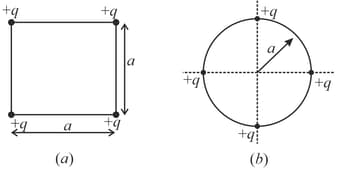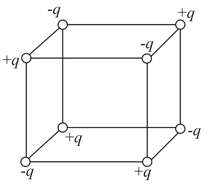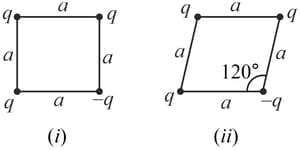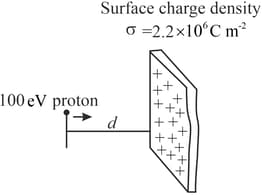B M Sharma Solutions for Chapter: Electric Potential, Exercise 3: Concept Application Exercise
B M Sharma Physics Solutions for Exercise - B M Sharma Solutions for Chapter: Electric Potential, Exercise 3: Concept Application Exercise
Attempt the free practice questions on Chapter 3: Electric Potential, Exercise 3: Concept Application Exercise with hints and solutions to strengthen your understanding. PHYSICS for Joint Entrance Examination JEE (Advanced) Electrostatics and Current Electricity solutions are prepared by Experienced Embibe Experts.
Questions from B M Sharma Solutions for Chapter: Electric Potential, Exercise 3: Concept Application Exercise with Hints & Solutions
Consider the configuration of a system of four charges each of value . Find the work done by external agent in changing the configuration of the system from figure (a) to figure (b).

Four charges and are placed in order on the four consecutive corners of a square of side . Find the work done in interchanging the positions of any two neighbouring charges of opposite sign.
Charges and are located at the corners of a cube of side as shown in the figure. Find the work done to separate the charges to infinite distance.

Two charged particles having charge and and of mass each are held at rest while their separation is . Find the speed of the particles when their separation is .
Four point charges and are placed at the vertices of a square of side length as shown in Figure below. The arrangement is changed and the charge are positioned at the vertices of a rhombus of side length with charge at the vertex where angle is as shown in the second figure below. Find the work done by the external agent is changing the configuration.

A proton is projected directly towards a large metal plate that has surface charge density of . From what distance must the proton be projected, if it is just fail to strike that plate?

A particle () having charge and mass is at rest and is free to move. Another particle () having charge and mass is projected from a large distance towards the first particle with speed . Calculate the least kinetic energy of the system during the subsequent motion. Final velocity of both the particles. Consider coulomb force only.
A particle () having a charge and mass and another particle () having charge and mass are initially held at a distance apart. Particle is projected directly towards with velocity and particle is released simultaneously. Find the velocity of particle after a long time. Consider coulomb force only.
